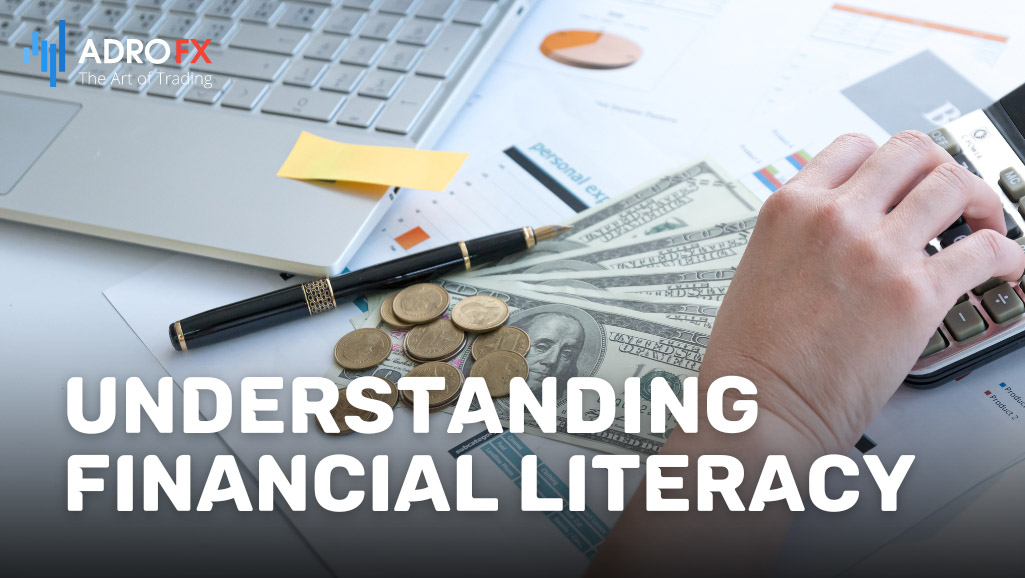Money Matters: Your Guide to Financial Literacy

Did you realize that recent research indicates nearly two-thirds of Americans struggle to pass even a basic financial literacy test? Financial literacy isn't just about grasping the concept of money; it's about empowering oneself to make well-informed financial decisions that shape one's future.
Financial literacy spans across all age groups, from young adults managing their first paycheck to seniors planning their retirement. It equips individuals with the knowledge and skills necessary to navigate the intricate realm of personal finance, encompassing budgeting, saving, investing, and credit management. Without a grasp of financial literacy, people may find it challenging to attain their financial aspirations, often accumulating debt and encountering financial insecurity.
Within this article, we aim to dissect the notion of financial literacy, its pivotal components, and underscore why everyone must cultivate these skills. We'll explore critical areas such as budgeting, saving, investing, and credit management, providing actionable advice and insights to elevate your financial literacy and seize control of your financial destiny.

Understanding Financial Literacy
Financial literacy denotes the aptitude to comprehend and proficiently manage one's finances. It entails possessing the knowledge and acumen to make informed decisions regarding earning, spending, saving, and investing money. Individuals well-versed in financial literacy are better equipped to establish financial objectives, craft and adhere to budgets, accrue savings for emergencies and long-term goals, make judicious investment choices, and handle debt sensibly.
The components of financial literacy encompass:
- Budgeting
Budgeting serves as the cornerstone of financial literacy. It involves meticulously tracking income and expenditures, discerning spending patterns, and allocating resources across various categories like housing, transportation, sustenance, and leisure. By adhering to a budget, individuals can live within their means, prioritize expenditures, and realize their financial ambitions.
- Saving
Regular saving is pivotal for fostering financial stability and realizing long-term aspirations such as homeownership, educational pursuits, or a comfortable retirement. Those adept in financial literacy appreciate the significance of consistent saving, setting aside funds for contingencies, and leveraging retirement savings schemes and other investment avenues.
- Investing
Investing stands as a critical facet of financial literacy, affording individuals the opportunity to augment their wealth over time. It entails channeling funds into assets such as stocks, bonds, mutual funds, and real estate, with the anticipation of yielding returns. A sound comprehension of investment fundamentals, risk tolerance, and portfolio diversification is indispensable for making informed investment decisions and crafting a well-balanced investment portfolio.
- Credit Management
Prudent credit management is paramount for nurturing a robust financial standing. This entails comprehending the mechanics of credit, maintaining a favorable credit score, sidestepping debt pitfalls like high-interest loans and credit card debt, and deploying credit judiciously to fulfill financial objectives.
By honing expertise in these pivotal domains, individuals can elevate their financial literacy and seize command of their financial future. In the subsequent sections, we'll delve deeper into each component, furnishing actionable strategies and insights to enhance your financial literacy and realize your financial aspirations.
Budgeting Basics
Budgeting serves as a fundamental pillar of financial literacy, offering a roadmap for effectively managing your finances. Without a budget, it's all too easy to overspend, live beyond your means, and find yourself drowning in debt. Budgeting, however, empowers you to track your income and expenses, pinpoint areas where savings are possible, and align your spending with your financial objectives. By establishing and adhering to a budget, you pave the way toward greater financial stability, alleviate stress surrounding money matters, and inch closer to your long-term financial aspirations.
Here are the essential steps to craft a budget:
- Track Income and Expenses
Begin by meticulously documenting all sources of income, encompassing wages, salaries, bonuses, and any other revenue streams. Next, scrutinize your expenditures by combing through bank statements, receipts, and bills. Distinguish between fixed expenses (e.g., rent, mortgage, utilities) and variable expenses (e.g., groceries, entertainment, dining out). - Categorize Spending
Once you've gained clarity on your income and outflows, categorize your expenditures into distinct categories such as housing, transportation, sustenance, entertainment, and savings. This segmentation facilitates the identification of areas where overspending occurs and offers avenues for potential cutbacks. - Set Financial Goals
Define your short-term and long-term financial objectives, be it eliminating debt, amassing a down payment for a home, or establishing an emergency fund. Allocate a portion of your income toward these goals to ensure steady progress toward their achievement. - Adjust and Monitor Your Budget
Regularly revisit your budget to monitor your advancement, make necessary adjustments, and pinpoint areas for further savings or reallocation of funds. Be adaptable and open to modifying your budget as your financial circumstances evolve or unforeseen expenses crop up.
An array of budgeting tools and applications are at your disposal to facilitate the creation and management of your budget. Renowned budgeting apps like Mint, YNAB (You Need a Budget), and Personal Capital enable you to monitor your spending, delineate financial goals, and oversee your progress in real-time. These resources streamline the budgeting process, furnish insights into your spending patterns, and keep you on course toward your financial objectives.

Saving and Emergency Funds
Saving money constitutes a cornerstone of financial literacy and represents a pivotal element of financial security. Saving empowers you to erect a financial safety net for unanticipated expenses, pursue long-term aspirations, and brace for forthcoming financial necessities such as retirement or significant acquisitions. By instilling a habit of regular saving, you cultivate a sense of financial reassurance and tranquility, cognizant that funds are available for emergencies and opportunities alike.
An emergency fund stands as a linchpin of any financial blueprint, furnishing a buffer against unforeseen expenses like medical bills, vehicular repairs, or job loss. To establish an emergency fund, set a savings target predicated on your monthly outlays and endeavor to accumulate reserves equivalent to three to six months' worth of living expenses. Initiate the process by earmarking a modest sum each month and progressively augmenting your savings until the goal is attained. Store your emergency fund in a dedicated savings account that affords ready accessibility while remaining distinct from your routine checking account.
Several types of savings accounts are at your disposal, each boasting unique attributes and advantages. Conventional savings accounts tendered by banks and credit unions represent a secure repository for your emergency fund, rendering facile access to your reserves when necessitated. High-yield savings accounts proffer interest rates surpassing those of traditional savings accounts, thereby catalyzing swifter wealth accumulation. Money market accounts amalgamate the traits of savings accounts with the augmented interest rates typically associated with investment accounts, presenting a versatile and accessible avenue for saving and accruing interest on your funds. Select the savings account type that aligns most seamlessly with your requisites and financial aspirations, bearing in mind considerations such as interest rates, fees, and accessibility.
Understanding Credit
Credit serves as a financial mechanism enabling individuals to borrow money or procure goods and services with the commitment of repayment at a later date. It stands as a cornerstone of personal finance, facilitating acquisitions, securing loans for significant investments like homes or vehicles, and fostering the establishment of a financial track record. Credit manifests in various forms, encompassing credit cards, loans, mortgages, and lines of credit.
A credit score epitomizes a numerical gauge of an individual's creditworthiness, predicated on their credit history and financial conduct. Ranging typically from 300 to 850, higher credit scores connote reduced risk to lenders and heighten the likelihood of securing favorable loan terms. Credit reports furnish comprehensive insights into an individual's credit history, encompassing accounts, payment records, outstanding balances, and inquiries. Lenders leverage credit reports and scores to evaluate an individual's risk profile when adjudicating loan applications or extending credit.
Cultivating and upholding commendable credit is instrumental in realizing financial objectives and accessing advantageous loan conditions. Key strategies for fostering and preserving robust credit encompass:
- Paying Bills on Time
Timely settlement of bills, loans, and credit card balances represents a linchpin in upholding a favorable credit score. Delinquent payments can precipitate substantial adverse repercussions on credit scores and potentially incur supplementary fees and penalties. - Keeping Balances Low
Prudent management of credit card balances vis-a-vis credit limits underscores responsible credit management and can exert a favorable influence on credit scores. Ideally, individuals should strive to utilize no more than 30% of their available credit at any juncture. - Avoiding Excessive Debt
Excessive indebtedness vis-a-vis income levels can strain financial resources and deleteriously affect credit scores. It is imperative to borrow prudently, within the confines of one's repayment capacity, and eschew maxing out credit cards or assuming superfluous loans.
Credit cards wield considerable utility as financial instruments when wielded judiciously, furnishing convenience, security, and incentives. Nonetheless, circumspection is imperative to avert the pitfalls of indebtedness. Pros associated with judicious credit card usage encompass the establishment of credit history, the accrual of rewards such as cash back or travel miles, and access to safeguards like purchase protection and fraud liability. Conversely, cons encompass the imposition of high-interest rates on outstanding balances, potential levies, and the temptation of profligate spending.

Basics of Investing
Investing stands as a cornerstone of personal finance, offering individuals the opportunity to augment their wealth gradually and realize enduring financial aspirations such as retirement, education, or homeownership. By allocating resources to assets poised for appreciation, individuals can cultivate returns and fortify their financial standing over protracted periods. Moreover, investing serves as a bulwark against inflation, safeguarding purchasing power over time.
An array of investment avenues beckons investors, each characterized by distinct risk and return profiles:
- Stocks
Represent ownership stakes in publicly traded companies, affording prospects for capital appreciation and dividend yields. - Bonds
Consist of debt instruments issued by governments or corporations, furnishing periodic interest disbursements and eventual repayment of principal at maturity. - Mutual Funds
Constitute pooled investment vehicles that channel resources into a diversified array of stocks, bonds, or alternative assets, overseen by adept fund managers. - Real Estate
Encompasses tangible properties or real estate investment trusts (REITs), harboring potential for rental income streams and asset valuation appreciation.
Risk and return underpin the bedrock of investing, epitomizing the interplay between potential returns and susceptibility to losses. Ordinarily, investments bearing loftier return potential often entail heightened levels of risk. Proficiency in comprehending risk tolerance, investment objectives, and time horizon is pivotal in crafting an investment blueprint harmonized with individual proclivities and objectives.
Investment strategies pivot on individual predilections, aspirations, and risk appetites:
- Long-term vs. Short-term
Long-term investment proponents espouse enduring asset retention to harness growth opportunities and capitalize on compounding returns. In contrast, short-term investors may capitalize on ephemeral market dynamics or price fluctuations to secure swift profits. - Diversification
Advocates the dispersion of investments across disparate asset classes, industries, and geographic spheres to curtail risk exposure and mitigate the repercussions of market tumult. By embracing diversification, investors can ameliorate risk and bolster prospects of procuring consistent returns across time horizons.
Managing Debt
Debt, a ubiquitous facet of financial management, delineates into two primary categories: good debt and bad debt. Good debt serves to fund investments poised for appreciation over time or capable of generating income, encompassing ventures such as education, home mortgages, or entrepreneurial endeavors. In contrast, bad debt materializes from expenditures that depreciate swiftly or fail to yield enduring benefits, exemplified by credit card debt incurred for non-essential spending or exorbitant payday loans.
The adept management of debt stands as a linchpin in fostering financial stability and realizing long-term objectives. Strategies for navigating debt encompass:
- Debt Repayment Plans
Craft a structured blueprint for extinguishing debts, commencing with high-interest obligations before progressively addressing lower-interest liabilities. Employ methodologies like the debt snowball method (eliminating debts from the smallest to the largest) or the debt avalanche approach (tackling debts with the loftiest interest rates first).
- Debt Consolidation
Streamline multiple debts into a solitary loan featuring a reduced interest rate, thereby streamlining repayment endeavors and potentially curtailing aggregate interest expenses. Debt consolidation avenues span balance transfer credit cards, personal loans, or home equity financing.
- Seeking Professional Guidance, if Necessary
In instances of grappling with debt management independently, contemplate soliciting aid from reputable credit counseling agencies or financial advisors. These seasoned professionals furnish tailored guidance, engage in negotiations with creditors, and aid in formulating pragmatic debt repayment strategies.
To preempt succumbing to debt pitfalls, cultivating responsible financial habits and exercising prudence when leveraging borrowing mechanisms becomes imperative. Practices to forestall debt entanglements comprise:
- Living Within Means
Adhere to a lifestyle aligned with income, eschewing gratuitous purchases or succumbing to lifestyle inflation. - Building an Emergency Fund
Accrue reserves earmarked for unforeseen expenses, diminishing dependence on credit during bouts of financial adversity. - Exercising Prudent Credit Utilization
Navigate credit card usage judiciously, refrain from maxing out credit limits, and settle balances in entirety monthly to avert accruing exorbitant interest charges. - Thoroughly Assimilating Loan Stipulations
Pore over loan agreements, interest rates, and repayment conditions meticulously before embracing debt commitments, ensuring a comprehensive understanding of financial obligations.

Planning for the Future
Retirement planning stands as an indispensable facet in securing financial stability during one's later years. It encompasses various elements crucial for ensuring a comfortable retirement:
Employer-Sponsored Plans provide a cornerstone for retirement savings. Leveraging options like 401(k) or 403(b) plans not only facilitates systematic savings but may also entail employer matching contributions, bolstering one's retirement nest egg.
Individual Retirement Accounts (IRAs) serve as invaluable tools for fortifying retirement finances. Whether utilized to complement employer-sponsored plans or as standalone vehicles for self-employed individuals lacking access to company retirement schemes, IRAs offer avenues for strategic retirement planning.
Investment Strategy assumes paramount significance in sculpting a robust retirement portfolio. Tailoring investment approaches to align with retirement aspirations necessitates meticulous consideration of factors like risk tolerance, investment horizon, and desired post-retirement lifestyle.
Insurance assumes a pivotal role in mitigating financial risks and safeguarding against unforeseen adversities. Health insurance shields against exorbitant medical expenses, while life insurance furnishes a financial cushion for loved ones in the event of the policyholder's demise. Disability insurance, meanwhile, extends vital support by offsetting income loss stemming from illness or injury.
Estate Planning, although often overlooked, constitutes a critical aspect of retirement preparation. Crafting a meticulously outlined will delineating asset distribution upon demise ensures the realization of one's legacy as envisioned. Assigning power of attorney to trusted individuals empowers them to make crucial financial and healthcare decisions in case of incapacity, thereby safeguarding one's interests. Regular review and updating of beneficiary designations on various financial instruments guarantee alignment with evolving estate planning objectives, facilitating a seamless transfer of assets.
Conclusion
In this comprehensive manual on financial literacy, we've delved into crucial topics aimed at empowering individuals to seize control of their finances and forge a stable future. From grasping the fundamentals of financial literacy to adeptly managing debt, orchestrating retirement plans, and fortifying against financial uncertainties, each segment has furnished invaluable insights and actionable strategies.
Understanding that financial literacy transcends a singular undertaking, we recognize it as an enduring expedition. Through perpetual self-education on personal finance and the cultivation of prudent financial practices, we equip ourselves to navigate with acumen, surmount financial hurdles, and realize our aspirations. Whether embarking on the nascent stages of financial enlightenment or augmenting existing knowledge, sustained learning and proactive financial stewardship stand as linchpins for attaining financial well-being and resilience.
Embark on your journey towards bolstering financial literacy today. Pledge to expand your understanding of personal finance, whether by immersing in literature, engaging in workshops, or soliciting guidance from financial experts. Establish concrete financial objectives, craft a budget, and vigilantly track your progress. Remember, each stride taken towards enhancing financial literacy propels you nearer to the realms of financial liberty and assurance.
About AdroFx
Established in 2018, AdroFx is known for its high technology and its ability to deliver high-quality brokerage services in more than 200 countries around the world. AdroFx makes every effort to keep its customers satisfied and to meet all the trading needs of any trader. With the five types of trading accounts, we have all it takes to fit any traders` needs and styles. The company provides access to 115+ trading instruments, including currencies, metals, stocks, and cryptocurrencies, which make it possible to make the most out of trading on the financial markets. Considering all the above, AdroFx is the perfect variant for anyone who doesn't settle for less than the best.










